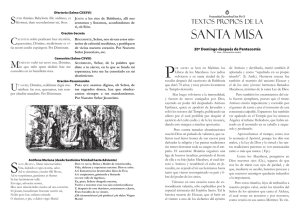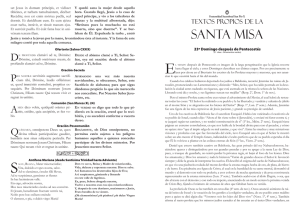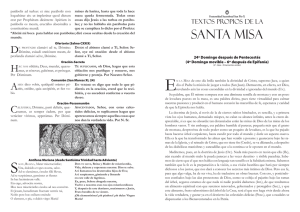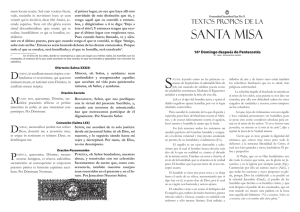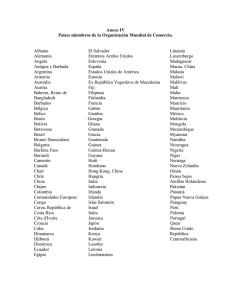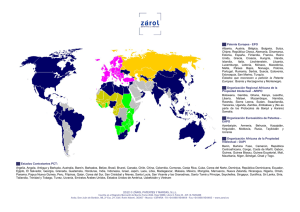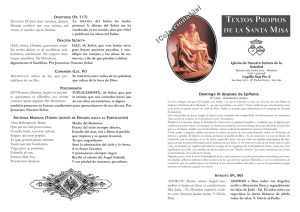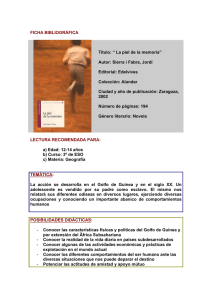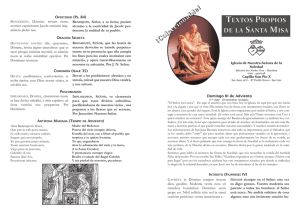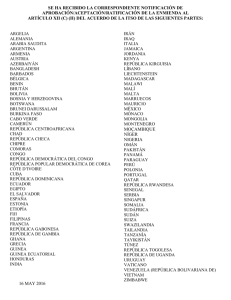DóMINE - Trasmeships
Anuncio
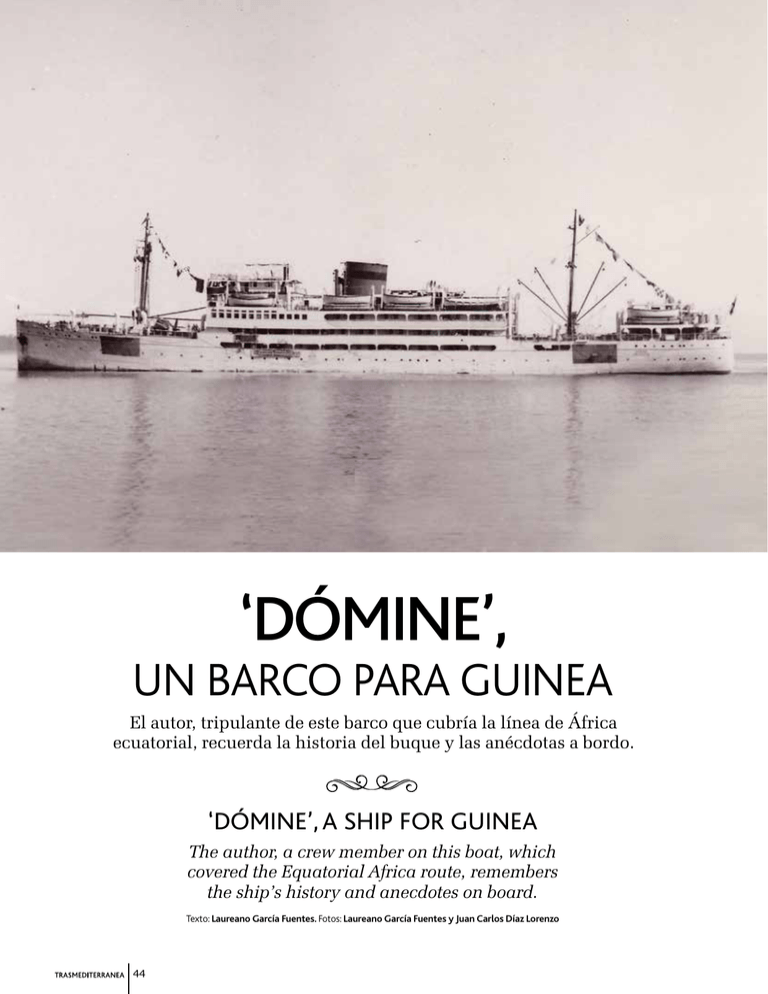
‘DóMINE’, UN BARCO PARA GUINEA El autor, tripulante de este barco que cubría la línea de África ecuatorial, recuerda la historia del buque y las anécdotas a bordo. ‘dómine’, A SHIP FOR GUINEA The author, a crew member on this boat, which covered the Equatorial Africa route, remembers the ship’s history and anecdotes on board. Texto: Laureano García Fuentes. Fotos: Laureano García Fuentes y Juan Carlos Díaz Lorenzo 44 la flota ANIVERSARIO TRASMEDITERRANEA En 1965, cuando aún no había cumplido los 18 años, entré a formar parte de la tripulación del Dómine, como alumno de máquinas. En 1963, el barco había vuelto a cubrir la línea de Guinea después de sufrir una gran reparación de más de un año de duración. Era este un buque cuya historia comenzó en 1931, año en el que la Compañía Trasmediterránea resultó adjudicataria de un concurso para operar, por un periodo de 20 años, todas las líneas marítimas de soberanía, incluida la de Guinea. Por ello, hubo de asumir la condición de construir dos buques mixtos de carga y pasaje adaptados a las necesidades de esta línea. Al año siguiente, la Compañía Trasmediterránea contrató la construcción de los dos buques requeridos –uno, con la Sociedad Española de Construcción Naval y el otro, con Euskalduna–. La construcción del primero de ellos se inició en la factoría de Sestao a principios de 1933. El 27 de julio de 1934 se procedió a su botadura imponiéndosele el nombre de Dómine, como homenaje a la figura de su fundador y primer presidente, José Juan Dómine. El nuevo buque fue entregado a sus propietarios en septiembre de 1935, incorporándose al servicio en la línea Bilbao-Guinea. Su gemelo, botado el 28 de agosto de 1934, recibió el nombre de Fernando Poo, En junio de 1940, el ‘Dómine’ realizó su único viaje trasatlántico, desde Génova hasta Buenos Aires acorde a la línea a la que iba destinado, y, entregado en septiembre de 1935, realizó su viaje inaugural desde Barcelona en octubre de ese año. Eran dos espléndidas motonaves de 6.900 TRB, con 124 m de eslora y 16,5 m de manga y, a plena carga, presentaban un calado de 6,7 m. Propulsados por dos motores diésel de 2.500 CV de potencia cada uno, alcanzaban una velocidad de 16 nudos. De acuerdo a las necesidades de la línea a la que iban destinados, disponían de una gran capacidad de bodegas y unas lujosas y confortables cámaras para el pasaje (el mobiliario de los salones y cámara de primera clase era de caoba y los de segunda clase, de roble americano). Tenían una bonita y característica estampa marinera marcada por su popa de crucero y su cubierta principal descubierta lateralmente. CARRERA MILITAR Los dos gemelos prestaron servicio sin novedad hasta 1936, cuando comenzó la guerra civil española, durante la cual el Dómine, que quedó bajo el bando nacional, fue habilitado como crucero auxiliar y armado con cuatro piezas de artillería de 101,6 mm procedentes del acorazado España. I joined the crew of the Dómine as an engineer cadet in 1965; I hadn’t even turned 18. The ship had just started covering the Guinea route again, in 1963, after undergoing extensive repairs that took more than a year to complete. This ship’s story began in 1931, the year that the Trasmediterranea Company won a tender to operate all of the maritime routes under national jurisdiction, including the Guinea route, for a period of 20 years. This tender was granted under the condition that the company build two mixed cargo and passenger ships adapted to this route’s needs. So, the following year, the Trasmediterranea Company hired the Spanish Society of Naval Construction and Euskalduna to build the ships; they would each build one. The construction of the first ship began in a shipyard in Sestao in early 1933. On July 27, 1934, it was launched under the name Dómine, in honour of the Company’s founder and first president, José Juan Dómine. The new ship was delivered to its owners in September 1935 and joined the service on the En la página anterior, el Dómine en aguas de Guinea durante la Segunda Guerra Mundial. On the previous page, the Dómine off the coast of Guinea during the Second World War. 45 ANIVERSARIO TRASMEDITERRANEA El mobiliario del salón de primera clase (en la imagen superior) era de caoba. The furniture in the first class lounge (in the image at the top) was made out of mahogany. la flota En enero de 1937 fue desmilitarizado para realizar un viaje extraordinario con peregrinos marroquíes a La Meca y, con el nombre de Mogreb El Aska, inició en Ceuta su histórico viaje, siendo escoltado primero por los cruceros Canarias y Baleares, en aguas del Norte de África, y después por buques de la Marina italiana hasta alcanzar el Canal de Suez. Permaneció tres semanas en Masaua regresando a España en el mes de marzo. Tras este viaje, el Dómine fue transformado en transporte rápido de guerra y artillado con piezas de 150 mm, enarbolando de vez en cuando bandera alemana –con el nombre de Archenfels– y otras veces bandera italiana –con el de Stelvio– hasta que, a finales de 1938, fue desarmado y empleado como buque de transporte en el Mediterráneo. Finalizada la contienda, fue desarmado y devuelto a la Compañía Trasmediterranea. Peor suerte corrió su gemelo Fernando Poo, al servicio del bando republicano, que fue hundido en aguas de Bata el 14 de octubre de 1936. 46 Bilbao-Guinea route. Its twin, launched on August, 28, 1943 and named Fernando Poo after the line it would be allocate to, was delivered in September 1935 and made its maiden voyage from Barcelona in October of that year. Both were splendid 6900 GRT motor ships, with a length of 124 m, a beam of 16.5 m and, when fully loaded, a draft of 6.7 m. Propelled by two 2500 HP diesel motors, they reached speeds of up to 16 knots. In accordance with the needs of the route they were assigned to, they had large holds and very luxurious and comfortable accommodations (the furniture in the lounges and first-class cabins was made out of mahogany and the furniture in the second-class cabins was made out of American oak). The stern of each ship featured a beautiful and characteristic naval figure and the main deck was open both sides. El Dómine continuó sus viajes de la línea de Guinea y, en junio de 1940, realizó su único viaje trasatlántico, desde Génova a Buenos Aires con escalas intermedias en Barcelona, Santa Cruz de Tenerife, Río de Janeiro, Santos y Montevideo. Hasta mediados de la década de los años cincuenta fue en la línea de Guinea donde, principalmente, prestó sus servicios siendo un barco muy identificado con el entorno colonial. Durante su estancia en Santa Isabel, el buque se convertía en centro social de la colonia española, donde se celebraban fiestas y otros eventos. La población autóctona también sentía un especial cariño por el Dómine Valencia, como familiarmente era conocido entre ellos debido a que relacionaban el nombre del barco con el puerto de registro que figuraba en sus dos aletas. Durante esta época fue usado muchas veces como buque comodín, prestando servicios en el sector de Baleares y también en la línea de Sevilla a Canarias. En enero de 1958, el Dómine se vio envuelto nuevamente en actividades militares al ser movilizado para el transporte de personal y material de guerra desde el puerto de Valencia a Cabo Juby, con motivo de las operaciones derivadas de la invasión y ataques a las guarniciones españolas. A finales de 1961 se le sometió a una importante reparación, que se prolongó durante todo el año 1962 y, a principios de febrero de 1963, se reincorporó a la línea de Guinea, aunque puntualmente prestaba servicios entre la Península y los puertos de Baleares y Canarias. MILITARY CAREER The twin ships provided service without a hitch until 1936, when the Spanish civil war began. During this time, the Dómine, which remained under the national flag, was outfitted as an auxiliary cruiser and armed with 101.6 mm naval guns taken from the battleship España. In January 1937, the Dómine was demilitarised in order to make an extraordinary journey with Moroccan pilgrims to Mecca and, under the name Mogreb El Aska, it began its historic voyage from Ceuta, first being escorted by the cruisers Canarias and Baleares, in the waters of North Africa, and then by ships from the Italian Navy until reaching the Suez Canal. It stayed in Masaua for three weeks, returning to Spain in the month of March. Following this trip, the Dómine was turned into a rapid war transport ship and outfitted with 150 mm naval guns, sometimes flying a German flag –under the name Archenfels– and other times an Italian flag –under the name Stelvio– until, at the end of 1938, it was disarmed and used as a transport ship in the Mediterranean. When the conflict ended, the Dómine was disarmed and returned to the Trasmediterranea Company. Its twin, Fernando Poo, was not so lucky; under the Republican side, it was sunk off ficha técnica ‘dómine’ (1935-1976) Facts Toneladas brutas / Gross tonnage: 6.914 Toneladas netas / Net tonnage: 3.866 Toneladas de peso muerto / Deadweight tonnage: 4.146 Eslora total / Total length: 124 m Eslora entre perpendiculares / Length between perpendiculars: 119,4 m Manga / Breadth: 16,5 m Puntal / Depth: 8,85 m Calado máximo / Maximum draught: 6,7 m Pasajeros / Passengers: 261 Equipo propulsor / Propulsion system: Dos motores diésel de 2.500 CV de potencia cada uno. Two Burmeister & Wain motors. Velocidad : 16 nudos. Speed: 16 knots. El Domine ha servido de inspiración pictórica como se aprecia, a la izquierda, en la acuarela de Vicente Pérez Molias. The Dómine served as an inspiration for paintings, like the watercolour by Vicente Pérez Molias to the left. 47 ANIVERSARIO TRASMEDITERRANEA la flota En el verano de 1965, el Dómine pasó a cubrir servicios en el sector de Baleares, concretamente en la línea Barcelona-Palma, y allí tuve la ocasión de conocer el ambiente bullicioso y alegre de los viajes de vacaciones a Mallorca. Sobre estas líneas, imagen del comedor de primera clase. Above these lines, a picture of the firstclass dining-room. Durante su estancia en Santa Isabel, en el ‘Dómine’ se celebraban fiestas y era el centro social de la colonia the coast of Bata on October 14, 1936. The Dómine continued its trips on the Guinea route and, in June 1940, it made its only transatlantic voyage, from Genoa to Buenos Aires, with stops in Barcelona, Santa Cruz de Tenerife, Rio de Janeiro, Santos and Montevideo. Up until the mid-fifties, it mainly provided its services on the Guinea route and was a symbol of the colonial presence there. During its stay in Santa Isabel, the ship became a social centre for the Spanish colony and a place where parties and other events were held. The local people also felt a special fondness for the Dómine Valencia, as they called it, combining the name of the ship with the port where it was registered, which was written on the quarters. During this time, the ship was used like a catchall, providing services in the Balearic Islands and also on the route from Seville to the Canary Islands. In January 1958, the Dómine was once again engaged in military activities, being mobilised 48 LA VIDA A BORDO El retorno del Dómine a la línea de Guinea coincidió con mi incorporación a Trasmediterránea, lo que me permitió realizar dos viajes completos a la antigua colonia española visitando Santa Isabel, San Carlos y Bata. La emoción que sentí cuando subí al barco quedó grabada en mi mente para toda la vida así como la melancolía que me invadió cuando, saliendo de Cádiz rumbo a Canarias, vi alejarse por la popa a la ciudad y a los seres queridos que allí quedaron y que, con inmensa alegría, acudieron a recibirme al regreso. A bordo viví la experiencia tropical, en la que además de protegernos del paludismo con pastillas de quinina, la jornada “de día” era de cuatro de la mañana a doce del mediodía para poder soportar el ambiente tórrido de la sala de máquinas que contrastaba, cuando estábamos en Santa Isabel, con el ambiente nocturno del bar-discoteca de la nigeriana Anita Guau, local donde sonaba música étnica y moderna, y donde, a veces, se podía presenciar la coreografía del “balele” con las bailarinas en topless. En los viajes de regreso, la tripulación del Dómine se to transport personnel and combat equipment from the Port of Valencia to Cape Juby, to support the operations prompted by an invasion and attacks on the Spanish garrisons. At the end of 1961, it underwent extensive repairs, which took all of 1962 to complete, and in February 1963, it returned to the Guinea route, occasionally providing services between the Peninsula and the Ports of Baleares and the Canary Islands. In the summer of 1965, the Dómine started covering services in the Balearic Islands, specifically on the Barcelona-Palma route, and there, I had the opportunity to experience the lively and cheerful atmosphere that accompanied vacation trips to Mallorca. LIFE ON BOARD The Dómine’s return to the Guinea route coincided with my start at Trasmediterranea and allowed me to make two complete trips to the old Spanish colony, visiting Santa Isabel, San Carlos and Bata. The excitement I felt veía aumentada con las mascotas adquiridas en Guinea –loros y algún que otro chimpancé–, que hacían las delicias del pasaje y tripulación hasta que eran recogidas por sus nuevos propietarios en el puerto de llegada. Recuerdo como un chimpancé, transportado por el calderetero, ayudaba a los engrasadores haciendo faenas de limpieza de pinturas en los mamparos de la sala de máquinas. Con la independencia de la colonia, el Dómine dejó de viajar a Guinea y sus servicios se centralizaron en las líneas que unían la Península con los archipiélagos.Por avatares del destino, el Dómine, buque construido especialmente para los servicios de Guinea, inició su vida marinera con un viaje a la Guinea Española en 1935 y la acabó repitiendo el viaje a la hoy Guinea Ecuatorial. El 17 de abril de 1975 salió de Barcelona y, después de hacer escala en Valencia y Las Palmas, atracó en Malabo el día 6 de mayo, de donde partió, en viaje de regreso a la península, el 20 de mayo siguiente. Posteriormente quedó inactivo en el puerto de Barcelona, mientras se tramitaba su baja en el Contrato de Comunicaciones Marítimas de Soberanía. ■ when I boarded the ship is etched in my mind forever, as is the melancholy that set in when, setting off from Cadiz en route to the Canary Islands, I watched from the ship’s stern as the city and my loved ones grew smaller and smaller in the distance. I’ll also never forget the joy of being reunited with them upon my return. On board, I had the tropical experience. We took quinine pills to prevent malaria and worked a “full” workday from four in the morning until noon to avoid the unbearable heat in the engine room in the afternoons. The oppressive heat of the day stood in contrast to the cool night atmosphere in the Nigerian Anita Guau bar and dance club in Santa Isabel, which played both modern and ethnic music and where, sometimes, you could see bare-breasted women dance the “balele”. On the return trips, the Dómine’s crew expanded to include the pets acquired in Guinea. Parrots and the occasional chimpanzee delighted the crew, made the journey more pleasant, and were picked up by their new owners at our destination. I remember how one chimpanzee, transported by the boilermaker, helped the greasers by cleaning up paint spilled in the bulkheads of the engine room. When the colony gained independence, the Dómine stopped travelling to Guinea and its services centred on the routes that united the Peninsula with the archipelagos. As fate would have it, the Dómine, a ship built especially for the Guinea services, began its life at sea with a trip to Spanish Guinea in 1935 and ended it by repeating the journey to what is now Equatorial Guinea. On April 17, 1975, it left Barcelona and, after making a stop in Valencia and Las Palmas, it docked in Malabo on May 6th and started the journey back to the Peninsula on May 20th. After that, it remained inactive in the Port of Barcelona, awaiting the official termination of the Contract of Sovereign Maritime Communications. ■ Arriba, el Dómine en Bilbao. Abajo, la pauta de acomodación de este barco y su gemelo, el Fernando Poo. Above, the Dómine in Bilbao. Below, the layout of this ship and its twin, the Fernando Poo. 49
